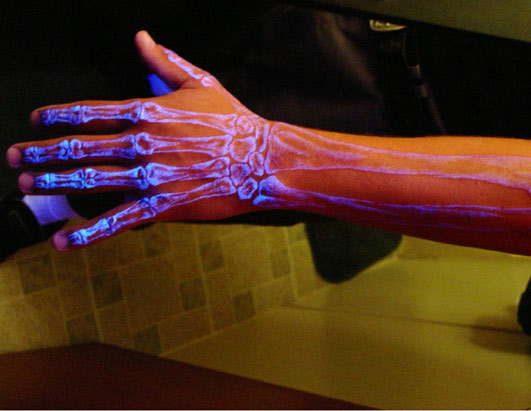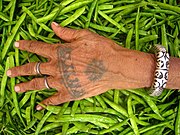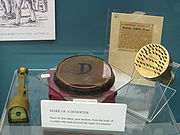
A tattoo is a permanent marking made by inserting ink into the layers of skin to change the pigment for decorative or other reasons. Tattoos on humans are a type of decorative body modification, while tattoos on animals are most commonly used for identification or branding.
Tattooing has been practiced worldwide. The Ainu, the indigenous people of Japan, traditionally wore facial tattoos. Today one can find Berbers of Tamazgha and Maori of New Zealand with facial tattoos. Tattooing was widespread among Polynesian peoples and among certain tribal groups in the Philippines, Borneo, Mentawai Islands, Africa, North America, South America, Mesoamerica, Europe, Japan, Cambodia, New Zealand and Micronesia. Despite some taboos surrounding tattooing, the art continues to be popular in many parts of the world.
Etymology
The origin of the word tattoo is from the Samoan word tatau, meaning "open wound".[1] The OED gives the etymology of tattoo as "In 18th c. tattaow, tattow. From Polynesian (Tahitian, Samoan, Tongan, etc.) tatau. In Marquesan, tatu." Englishmen mispronounced the word tatau and borrowed it into popular usage as tattoo.[1] Sailors on the voyage later introduced both the word and reintroduced the concept of tattooing to Europe.[2]
Tattoo enthusiasts may refer to tattoos as "Ink", "Tats", "Art", or "Work", and to tattooists as "Artists". The latter usage is gaining greater support, with mainstream art galleries holding exhibitions of both traditional and custom tattoo designs. Copyrighted tattoo designs that are mass-produced to tattoo artists are known as flash, a notable instance of industrial design. Flash sheets are prominently displayed in many tattoo parlors for the purpose of providing both inspiration and ready-made tattoo images to customers.
The Japanese word irezumi means "insertion of ink" and can mean tattoos using tebori, the traditional Japanese hand method, a Western style machine, or for that matter, any method of tattooing using insertion of ink. The most common word used for traditional Japanese tatoo designs is Horimono. Japanese may use the word "tattoo" to mean non-Japanese styles of tattooing.
History
Tattooing has been a Eurasian practice at least since Neolithic times. Ötzi the Iceman, dating from the fourth to fifth millennium BCE, was found in the Ötz valley in the Alps and had approximately 57 carbon tattoos consisting of simple dots and lines on his lower spine, behind his left knee, and on his right ankle. [19] Other mummies bearing tattoos and dating from the end of the second millennium BC have been discovered, such as the Mummy of Amunet from Ancient Egypt and the mummies at Pazyryk on the Ukok Plateau.[3]
Tattooing in Japan is thought to go back to the Paleolithic era, some ten thousand years ago.[citation needed] Various other cultures have had their own tattoo traditions, ranging from rubbing cuts and other wounds with ashes, to hand-pricking the skin to insert dyes.[citation needed]
Tattooing in the Western world today has its origins in Polynesia, and in the discovery of tatau by eighteenth century explorers. The Polynesian practice became popular among European sailors, before spreading to Western societies generally.[4]
Purposes
Decorative and spiritual uses

Tattoos have served as rites of passage, marks of status and rank, symbols of religious and spiritual devotion, decorations for bravery, sexual lures and marks of fertility, pledges of love, punishment, amulets and talismans, protection, and as the marks of outcasts, slaves and convicts. The symbolism and impact of tattoos varies in different places and cultures. Tattoos may show how a person feels about a relative (commonly mother/father or daughter/son) or about an unrelated person.

Today, people choose to be tattooed for cosmetic, sentimental/memorial, religious, and magical reasons, and to symbolize their belonging to or identification with particular groups, including criminal gangs (see criminal tattoos) but also a particular ethnic group or law-abiding subculture. Some Māori still choose to wear intricate moko on their faces. In Laos, Cambodia, and Thailand, the yantra tattoo is used for protection against evil and to increase luck. In the Philippines certain tribal groups believe that tattoos have magical qualities, and also to their bearers. Most traditional tattooing in the Philippines is related to the bearers Accomplishments in life or rank in the tribe.
Identification

People have also been forcibly tattooed for various reasons. The well known example is the identification system for inmates/Jews in concentration camps during the Holocaust. However, tattoos can be linked with identification in more positive ways. For example, in the period of early contact between the Māori and Europeans, Māori chiefs sometimes drew their moko (facial tattoo) on documents in place of a signature. Tattoos are sometimes used by forensic pathologists to help them identify burned, putrefied, or mutilated bodies. Tattoo pigment is buried deep enough in the skin that even severe burns will often not destroy a tattoo. Because of this, many members of today's military will have their identification tags tattooed onto their chests (these are sometimes known as "meat tags" in the American armed forces). For many centuries seafarers have undergone tattooing for the purpose of enabling identification after drowning. In this way recovered bodies of such drowned persons could be connected with their family members or friends before burial. Therefore tattooists often worked in ports where potential customers were numerous. The traditional custom continues today in the Royal Navy (Great Britain) and in many others.[1]
Tattoos are also placed on animals, though very rarely for decorative reasons. Pets, show animals, thoroughbred horses and livestock are sometimes tattooed with identification and other marks. Pet dogs and cats are often tattooed with a serial number (usually in the ear, or on the inner thigh) via which their owners can be identified. Also, animals are occasionally tattooed to prevent sunburn (on the nose, for example). Such tattoos are often performed by a veterinarian and in most cases the animals are anesthetized during the process. Branding is used for similar reasons and is often performed without anesthesia, but is different from tattooing as no ink or dye is inserted during the process.
Cosmetic
When used as a form of cosmetics, tattooing includes permanent makeup and hiding or neutralizing skin discolorations. Permanent makeup is the use of tattoos to enhance eyebrows, lips (liner and/or lipstick), eyes (liner), and even moles, usually with natural colors as the designs are intended to resemble makeup.
Medical
Medical tattoos are used to ensure instruments are properly located for repeated application of radiotherapy and for the areola in some forms of breast reconstruction. Tattooing has also been used to convey medical information about the wearer (e.g blood group).
Source : http://en.wikipedia.org/wiki/Tattoo


No comments:
Post a Comment